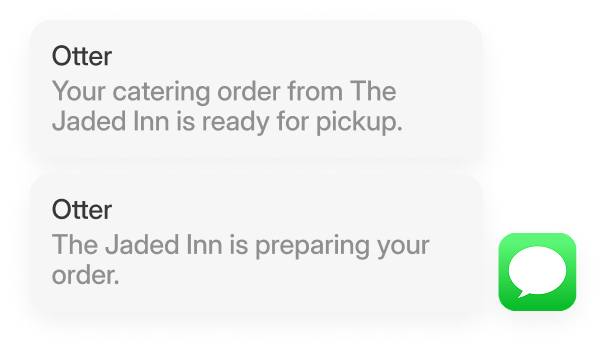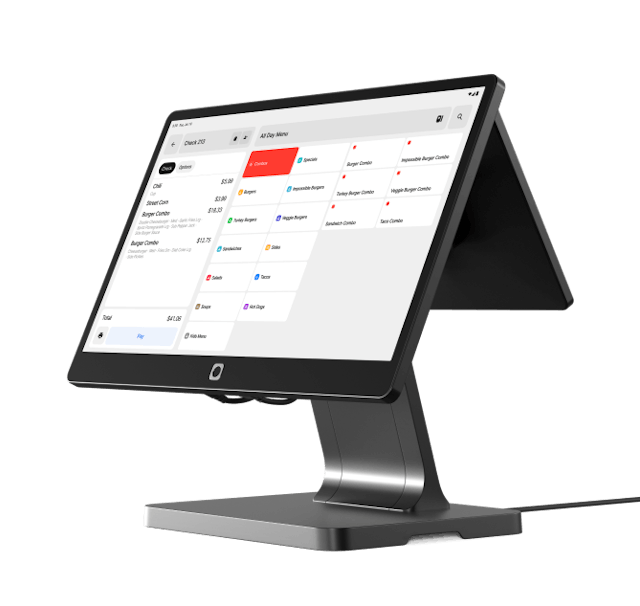
Table of contents
- What is voice ordering for restaurants and how it works
- Benefits of voice ordering for restaurants
- Challenges and considerations before adopting voice ordering
- Key technologies powering voice ordering systems
- Best practices for implementing voice ordering in restaurants
- Future trends and innovations in voice ordering
- Ready to explore voice ordering for your restaurant?
It's your busiest Friday night, phones are ringing off the hook, and your best server just called in sick. You're watching potential orders slip away because no one can answer fast enough.
This scenario is common in restaurants across the country – it happens every day. But what if there was a way to capture every order, even during your most hectic rushes, without adding more staff to your payroll?
Voice ordering technology is changing how restaurants handle customer orders, from drive-thru interactions to phone calls. Major chains like Taco Bell and Wendy’s have already begun integrating these AI-powered systems, and the results speak for themselves: faster ordering, fewer missed orders, and staff who can focus on what they do best—creating great food and memorable experiences.
For restaurant owners and operators, voice ordering isn't just about staying current with technology trends. It's about solving real operational challenges while improving the customer experience. Whether you're running a single location or managing multiple sites, understanding how voice ordering works—and how to implement it effectively—can give you a significant competitive advantage in the restaurant industry.
At Otter, we've worked with countless restaurants navigating digital transformation. In this guide, we'll walk you through everything you need to know about voice ordering: what it is, how it works, and most importantly, how to determine if it's right for your operation.
What is voice ordering for restaurants and how it works
Voice ordering allows your customers to place orders by simply speaking their requests—whether they're at your drive-thru, calling on the phone, using kiosks, or even ordering from home through smart devices. Instead of relying on staff to manually input every customer order, artificial intelligence handles the conversation naturally, processes the request, and sends it directly to your kitchen.
This tireless voice assistant never gets overwhelmed during rush periods, never mishears an order, and can handle multiple conversations simultaneously. The voice ai technology uses advanced speech recognition and natural language processing to understand what customers want, even when they say things like "I'll take my usual" or "Can I get that burger but make it spicy?"
The ordering process flows through several connected steps. Your guest speaks their order through any connected device, and the AI system immediately converts speech to text while identifying menu items, modifications, and quantities. The system confirms details with the customer, suggests add-ons for upselling opportunities, and handles special requests. Once confirmed, the order automatically populates in your POS system with all details and pricing in real-time. The order then appears instantly on your kitchen display system or prints as a ticket, formatted exactly like your other orders. Finally, the system processes payment and provides immediate confirmation to the customer.
The real advantage comes from seamless integration. Modern voice ordering systems connect with your existing POS, order management, and loyalty programs. When a regular customer calls in, the system can recognize their voice and instantly pull up their order history.
For restaurants already using comprehensive systems like Otter's multichannel platform, voice ordering becomes another channel alongside online ordering, kiosk orders, and traditional counter service. Everything flows through the same unified system, giving you complete visibility and control no matter how the customer communicates their choice.
Benefits of voice ordering for restaurants

Voice ordering is novel, but it’s also practical. For restaurant operators, these cutting-edge systems address fundamental operational challenges while creating new opportunities for growth. When implemented thoughtfully, voice ordering becomes a strategic tool that impacts everything from labor costs to customer satisfaction.
Faster Service and Improved Order Accuracy
Voice AI eliminates the back-and-forth miscommunication that can arise during busy periods. When customers speak their orders directly to an AI-powered system that's connected to your menu database, there's less room for human error. The technology can instantly verify food items, confirm modifications, and ensure pricing accuracy before the order reaches your kitchen.
Reduced Labor Costs During Peak Times
Don’t let your busiest periods lead to missed phone calls or overwhelmed staff. Voice ordering systems can handle multiple conversations – simultaneously – ensuring that every customer gets immediate attention even when your team is focused on food preparation and in-person service. This doesn’t mean replacing staff. Rather, it means freeing them to focus on tasks that require human attention, like ensuring food quality and creating positive guest experiences.
Enhanced Customer Experience and Accessibility
Voice ordering makes your restaurant more accessible to customers with disabilities while appealing to anyone who prefers hands-free interaction. Busy parents, commuters, or customers multitasking at home can place orders without navigating complex mobile apps. Natural conversation feels more intuitive than typing on a small screen.
Smarter Personalization and Upselling Through Customer Data
Voice ordering can be a powerful personalization tool when properly integrated with your existing customer data systems. Returning customers can be recognized by their voice patterns, allowing the AI solutions to suggest usual orders or recommend items based on previous purchases. This level of customization can increase average order values while making customers feel valued.
Better Data Collection for Business Insights
Every voice interaction generates valuable data about preferences, ordering patterns, and peak demand times. This information helps you make smarter decisions about everything: menu design, staffing, and inventory management. Voice systems can capture nuanced customer feedback in real-time, giving you insights that would be difficult to gather through traditional methods of order-taking.
Challenges and considerations before adopting voice ordering
While voice ordering offers compelling benefits, successful implementation requires careful planning and realistic expectations. Understanding potential hurdles upfront helps you make informed decisions and set your restaurant up for success.
Technology Integration and System Compatibility
The biggest challenge most restaurants face isn't the voice ordering technology itself, but ensuring it works flawlessly with existing operations. Your voice ordering system needs to communicate effectively with the following:
- POS system
- kitchen display system
- inventory management
- payment processing system
The key is choosing ordering solutions that are designed for hassle-free integration from the ground up. Modern restaurant management platforms that offer multiple ordering channels—like Otter’s comprehensive POS system that offers built-in online ordering, kiosk support, and food delivery integrations—typically handle voice ordering integration more smoothly than piecing together separate systems.
Initial Investment and Return Timeline
Voice ordering requires upfront investment in both technology and training. However, the cost equation becomes more favorable when you consider it as part of a broader operational upgrade rather than a standalone addition. Restaurants that approach voice ordering as one component of a multichannel strategy often see faster returns because they're solving multiple operational challenges at once. The key is realistic budgeting and understanding that ROI typically comes from increased order capacity and labor efficiency rather than immediate cost savings.
Staff Adaptation and Customer Education
Introducing any new ordering solution means change management for both your team and your customers. Your staff needs to understand how voice orders flow through your systems and how to handle situations when the technology needs human intervention. Customers, meanwhile, need clear guidance on how to use voice ordering effectively. A gradual rollout, rather than an overnight switch, generally proves more successful. Restaurants that provide good signage, patient staff support, and alternative ordering methods during the transition period tend to see higher adoption rates and reduced wait times.
Accuracy and Performance Expectations
Voice AI technology has improved dramatically, but it's not perfect. Background noise, strong accents, or complex custom orders can still present challenges. The most successful implementations combine voice AI with human oversight, allowing staff to step in when needed. Setting realistic expectations with both staff and customers helps prevent frustration during the learning period.
Privacy and Data Security Considerations
Voice ordering systems collect and process customer data, which means robust security measures and clear privacy policies are needed. Working with established technology providers who prioritize data security and compliance helps mitigate these concerns—Otter, for example, is a trusted technology provider because it has been certified with SOC 2, a rigorous standard demonstrating strong controls for data protection and information security. This same data, when properly managed, becomes a valuable resource for understanding customer preferences and improving service.
Key technologies powering voice ordering systems

Understanding the technology behind voice ordering helps restaurant operators make informed decisions about implementation and vendor selection. While the customer experience appears simple, several sophisticated systems work together to deliver reliable, accurate voice ordering.
Voice Recognition AI and Natural Language Processing
At the heart of every voice ordering system lies artificial intelligence that converts spoken words into text and interprets meaning. In a restaurant setting, this means the AI system can differentiate between "large pizza" and "large piece of pizza," understand when someone says "my usual," and interpret modifications like "hold the onions" or "extra spicy." Modern systems continuously learn from interactions, improving their ability to handle regional accents and background noise.
POS and Kitchen Display System Integration
Integration with POS systems ensures that voice orders automatically populate with correct pricing, apply discounts, and update inventory counts in real-time. Kitchen display system connectivity allows voice orders to appear formatted exactly like other orders, maintaining familiar workflows for your cooking staff and eliminating manual order entry.
Cloud-Based Order Management Platforms
Cloud infrastructure enables voice ordering systems to process multiple conversations simultaneously while maintaining consistent performance during peak periods. For restaurants using multichannel approaches, cloud-based management ensures all channels stay synchronized and orders flow through unified systems for tracking and fulfillment.
Voice-Enabled Hardware Solutions
The physical hardware varies depending on your restaurant's format. Drive-thru locations might use specialized speakers designed for outdoor environments, while counter service restaurants could implement smart kiosks with voice capabilities. Phone-based voice ordering integrates with existing phone systems, and some restaurants explore smart speaker integrations (like Alexa) for at-home ordering. The key is choosing hardware that fits your operational flow while maintaining reliability.
When these technologies work together effectively, they create an ordering experience that feels natural for customers and organizes operations for restaurant staff. The most successful implementations focus on how these components integrate with existing restaurant management systems rather than treating voice ordering as an isolated add-on.
Best practices for implementing voice ordering in restaurants
To successfully roll out a voice ordering system, you must plan strategically and roll out gradually. The restaurants that see the best results treat voice ordering as an operational enhancement rather than a complete overhaul, building on existing strengths while addressing specific challenges.
Start with a Focused Pilot Program
Rather than launching voice ordering across all locations simultaneously, begin with a controlled test environment. Choose your busiest location for the pilot—this gives you meaningful data quickly while limiting potential disruption. Focus on simple menu items and popular orders before expanding to complex customizations. Document what works well and what needs adjustment, creating a playbook for broader implementation.
Prepare Your Team for Success
Train your team to understand how voice orders flow through your systems, when to intervene to assist customers, and how to troubleshoot common issues. Equally important is training them to actively promote voice ordering to customers who might benefit from the convenience. Staff who understand the technology become advocates, helping customers feel confident about trying it out.
Optimize Your Menu for Voice Interaction
Voice ordering works best when menu items have clear, easily pronounced names that the AI can consistently recognize. Review your menu descriptions and consider simplifying complex item names. Items like "The Magnificent Seven Supreme Deluxe" might need simpler alternatives like "supreme pizza" for voice ordering. Work with your technology provider to train the system on your specific menu language and common customer nicknames for popular items.
Monitor Performance and Continuously Improve
Voice ordering systems improve over time, but they need active monitoring and optimization. Track key metrics like accuracy rates, average order completion times, and customer satisfaction scores specific to voice orders. Pay attention to which menu items or modifications cause the most confusion and work with your technology provider to refine recognition for problematic areas. Regular performance reviews help you identify opportunities for improvement and ensure the system continues meeting your operational needs as your business evolves.
Integrate with Your Broader Digital Strategy
Voice ordering delivers the most value when it's part of a comprehensive approach to restaurant technology. Integrate voice ordering with your existing POS, online ordering, loyalty programs, and customer data systems – beyond the seamless experience it delivers to customers, it gives you unified data for business insights. Restaurants using integrated multichannel platforms often see better adoption rates because voice ordering feels like a natural extension of familiar ordering options rather than a completely separate system.
Future trends and innovations in voice ordering
Voice ordering technology continues evolving rapidly, with new capabilities emerging that promise to make restaurant operations even more efficient and customer experiences more personalized. Understanding these trends helps restaurant operators plan for long-term technology investments and stay competitive in an increasingly digital marketplace.
The next generation of voice ordering systems will connect with loyalty programs to deliver highly personalized experiences. Imagine a regular customer calling in and the system automatically recognizing their voice, greeting them by name, and suggesting their usual order with modifications based on current promotions or seasonal availability. These AI solutions will also be able to offer targeted upsells based on purchase history, dietary preferences, and even the time of day. For restaurants with comprehensive customer data platforms, this level of personalization can significantly increase average order values.
Multilingual support is expanding beyond basic translation to true conversational fluency in multiple languages. This development is particularly valuable for restaurants serving diverse communities or tourist areas. Advanced systems will be able to switch between languages within a single conversation and understand cultural food preferences and ordering patterns. This capability removes language barriers that might prevent some customers from placing orders.
Integration with popular messaging apps and social media platforms represents a major frontier for voice ordering. Customers will soon be able to place orders through voice messages on platforms they already use daily, whether that's WhatsApp, Facebook Messenger, or other communication channels. This expansion makes ordering even more convenient by meeting customers where they already spend time online, while also providing restaurants with new touchpoints for customer engagement.
Perhaps the most exciting development is predictive ordering technology that learns individual customer patterns and preferences over time. These systems will be able to anticipate what customers want based on factors like previous orders, time of day, weather, local events, and seasonal trends. Eventually, regular customers might receive proactive suggestions or even have their likely orders prepared during predicted ordering windows. This level of automation could dramatically reduce wait times while increasing customer satisfaction through personalized service.
Voice ordering will become increasingly integrated with other smart restaurant technologies. This includes inventory management systems that can suggest menu modifications based on ingredient availability and kitchen automation that adjusts preparation times based on voice order volume. Restaurants using comprehensive technology platforms will be able to create truly connected experiences where voice ordering data informs everything from staffing decisions to menu development, helping to streamline operations across takeout, dine-in, and food delivery services.
These innovations point toward a future where voice ordering becomes not just a convenience feature, but a central component of restaurant operations that drives efficiency, personalization, and customer loyalty.
Ready to explore voice ordering for your restaurant?
Voice ordering represents a strategic tool for addressing real operational challenges while positioning your restaurant for future growth. From reducing labor bottlenecks during peak periods to creating more personalized customer experiences, the technology can transform operations when implemented thoughtfully as part of a comprehensive restaurant ecosystem.
At Otter, we understand that restaurant operators need technology that enhances operations without overwhelming teams. Our multichannel platform supports restaurants exploring innovative solutions like voice ordering, providing the integrated foundation that makes new technologies more effective and easier to manage. Clients love us – we offer 24/7 support and boast a track record of helping over 100,000 restaurants optimize their operations. We're here to help you navigate the evolving landscape of restaurant technology.
Whether you're ready to pilot voice ordering or still evaluating options, understanding how new technologies address your specific operational needs is key. Voice ordering isn't right for every restaurant, but for those facing challenges with order volume, staff efficiency, or customer convenience, it offers a promising path forward.

Otter POS for restaurants
The all-in-one platform that enhances operations across your entire business. Consolidate orders, increase sales, and make your days easier.

Book a demo to see how Otter’s all-in-one platform can help your restaurant thrive.